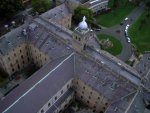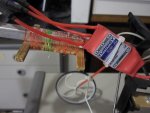glydr
How many letters do we ge
A lot of people use fancy multi-rotors for AP. But when starting out I recommend old-school fixed wing.
Here she is; my primary Aerial Photography (AP) aircraft:

Yep - that's a 36Mhz tx I'm holding there. Shows how old the photo is and how long I've had this plane.
Here is a more recent photo:

Note the new tail. I had to replace the old one with a working one after a magpie attacked my plane! About 1/3 of the horizontal stab was torn off but the plane safely returned home. Try that with your tri-copter!
These are still available and quite cheaply too. A major US distributor has the kit available for $36.
Why should you use a slow stick for aerial photography? Well;
1. It's slow (that's good; means there is less movement for the camera to deal with when you take a photo)
2. It's wing is under-cambered (that's also good; gives it high lift and payload capacity for carrying a camera)
3. It's 'fuselage' comprises a stick (that's good for hanging a camera off and other modifications)
4. It's undercarriage is tall (gives a lot of space for the camera)
5. It's super-easy to fly
In fact if you are thinking about giving this aerial photography stuff a go I can highly recommend this aircraft. It is a lot cheaper than the multi-rotor craft, a lot easier to set up and despite its simple appearance can produce some quality images.

For AP the SS needs some modifications.
Firstly, power.
Toss aside the brushed motor that comes in the box and buy yourself:
1. DT750 (~$11 and 79g)
2. TGY Plush ESC 25A (~$12 and 47g) - 18A could possibly do, but why would you when it's not that much more.
4. GWS 1147 SF props (~$5 and 93g)
5. 3S battery ~1800 (~$12 and 185g) the link shows the Rhino 1750 which balances the CoG nicely in my setup.
That's ~$40 and ~400g (which costs $10 shipping with another 100g up your sleeve). Total so far including kit is $86.

Note the brace across the undercarriage. With camera loaded this thing gets heavy, so the brace prevents the undercarriage legs from doing the splits and scratching your camera.

Note the timber cross-pieces attached to the frame with glued thread? The battery hangs there attached by velcro and rubber bands (bands go over the battery below and hook over the timber pieces).
Next modification is the camera mount:
I use an ASKMAN AP mount which I believe is no longer available.

I love the tilt-servo of the askman mount as it lets me adjust the camera angle from the ground depending on where I'm flying in relation to the target. It also lets me lift the mount up level when landing so as to prevent scratching the camera.
Another great feature is how the askman mount 'hangs' from the fuselage enabling the camera to stay level while the aircraft is pitching and rolling. It works like this:

Photo credit: 'aragon' on RCG
The top disc it attached to the fuselage so the mount hangs under the aircraft. This 'donut' arrangement is free to move about on ball links in all directions. To stop the camera swaying about this contraption is stuffed with sponge-foam (like in your couch, not EPP!). I use a velcro-strap 'collar' to keep the foam in place as seen on the photo of my mount above.
Also, you will see the shutter mechanism which is a nylon bolt which pushes on the shutter button. I'm currently using a Canon Ixus 100is which takes shot after shot when the shutter is held down. The Pentax Optio S series also have this feature.
Without askman mounts on the market you could make your own. Or if I was doing it again I'd probably go and get this one from blue sky rc:

Photo credit: bluesky rc
Whatever way you go note two important considerations:
1. Down angle; the camera has to face down somewhat as shown in the above photo. Make sure you get your wing out of the shot! Experiment to find what angle suits you (note how the blue sky item is adjustable)
2. Vibration isolation; the rubber foam (receiver saver in my case, stubby cooler rubber would also work or a mouse mat) seen on my camera mount helps isolate the camera from vibrations.
As for mounting, a nylon bolt screws into the tripod mount on the camera. Which way? Some people like to face the camera forwards; handy for video. I like the camera to point sideways for stills as you get to fly past the subject and take photos.
With airframe and mount done we are up to ~$110 (this assumes you bought a $20 mount from blue sky rc).
Now to choose a camera.
I'm very happy with my Canon (was ~$200 when purchased) and would buy an Ixus again if I needed to. I have had good results with Pentax Optio S4, S7 and S10 cameras. These are all compact point and shoot cameras in the 100 to 120g range which are easily carried by our DT750 powered slow stick. A friend here in Australia recently bought an Optio (S7 I think) on ebay for roughly $25 including post! So choose a model line, cruise the bay of e and start with a cheapy to experiment with.
Camera, plane, mount etc brings us to $135 (depending on what bargain you found on ebay!). Just need a couple of servos (say $10 worth) and a receiver (I use a $70+ AR7000, but use what you like as long as it is reliable - satellite rx recommended!).
In any case you could potentially get a good AP setup going with change from $150. I hope this thread encourages you to do so.
Here she is; my primary Aerial Photography (AP) aircraft:

Yep - that's a 36Mhz tx I'm holding there. Shows how old the photo is and how long I've had this plane.
Here is a more recent photo:

Note the new tail. I had to replace the old one with a working one after a magpie attacked my plane! About 1/3 of the horizontal stab was torn off but the plane safely returned home. Try that with your tri-copter!
These are still available and quite cheaply too. A major US distributor has the kit available for $36.
Why should you use a slow stick for aerial photography? Well;
1. It's slow (that's good; means there is less movement for the camera to deal with when you take a photo)
2. It's wing is under-cambered (that's also good; gives it high lift and payload capacity for carrying a camera)
3. It's 'fuselage' comprises a stick (that's good for hanging a camera off and other modifications)
4. It's undercarriage is tall (gives a lot of space for the camera)
5. It's super-easy to fly
In fact if you are thinking about giving this aerial photography stuff a go I can highly recommend this aircraft. It is a lot cheaper than the multi-rotor craft, a lot easier to set up and despite its simple appearance can produce some quality images.

For AP the SS needs some modifications.
Firstly, power.
Toss aside the brushed motor that comes in the box and buy yourself:
1. DT750 (~$11 and 79g)
2. TGY Plush ESC 25A (~$12 and 47g) - 18A could possibly do, but why would you when it's not that much more.
4. GWS 1147 SF props (~$5 and 93g)
5. 3S battery ~1800 (~$12 and 185g) the link shows the Rhino 1750 which balances the CoG nicely in my setup.
That's ~$40 and ~400g (which costs $10 shipping with another 100g up your sleeve). Total so far including kit is $86.

Note the brace across the undercarriage. With camera loaded this thing gets heavy, so the brace prevents the undercarriage legs from doing the splits and scratching your camera.

Note the timber cross-pieces attached to the frame with glued thread? The battery hangs there attached by velcro and rubber bands (bands go over the battery below and hook over the timber pieces).
Next modification is the camera mount:
I use an ASKMAN AP mount which I believe is no longer available.

I love the tilt-servo of the askman mount as it lets me adjust the camera angle from the ground depending on where I'm flying in relation to the target. It also lets me lift the mount up level when landing so as to prevent scratching the camera.
Another great feature is how the askman mount 'hangs' from the fuselage enabling the camera to stay level while the aircraft is pitching and rolling. It works like this:

Photo credit: 'aragon' on RCG
The top disc it attached to the fuselage so the mount hangs under the aircraft. This 'donut' arrangement is free to move about on ball links in all directions. To stop the camera swaying about this contraption is stuffed with sponge-foam (like in your couch, not EPP!). I use a velcro-strap 'collar' to keep the foam in place as seen on the photo of my mount above.
Also, you will see the shutter mechanism which is a nylon bolt which pushes on the shutter button. I'm currently using a Canon Ixus 100is which takes shot after shot when the shutter is held down. The Pentax Optio S series also have this feature.
Without askman mounts on the market you could make your own. Or if I was doing it again I'd probably go and get this one from blue sky rc:

Photo credit: bluesky rc
Whatever way you go note two important considerations:
1. Down angle; the camera has to face down somewhat as shown in the above photo. Make sure you get your wing out of the shot! Experiment to find what angle suits you (note how the blue sky item is adjustable)
2. Vibration isolation; the rubber foam (receiver saver in my case, stubby cooler rubber would also work or a mouse mat) seen on my camera mount helps isolate the camera from vibrations.
As for mounting, a nylon bolt screws into the tripod mount on the camera. Which way? Some people like to face the camera forwards; handy for video. I like the camera to point sideways for stills as you get to fly past the subject and take photos.
With airframe and mount done we are up to ~$110 (this assumes you bought a $20 mount from blue sky rc).
Now to choose a camera.
I'm very happy with my Canon (was ~$200 when purchased) and would buy an Ixus again if I needed to. I have had good results with Pentax Optio S4, S7 and S10 cameras. These are all compact point and shoot cameras in the 100 to 120g range which are easily carried by our DT750 powered slow stick. A friend here in Australia recently bought an Optio (S7 I think) on ebay for roughly $25 including post! So choose a model line, cruise the bay of e and start with a cheapy to experiment with.
Camera, plane, mount etc brings us to $135 (depending on what bargain you found on ebay!). Just need a couple of servos (say $10 worth) and a receiver (I use a $70+ AR7000, but use what you like as long as it is reliable - satellite rx recommended!).
In any case you could potentially get a good AP setup going with change from $150. I hope this thread encourages you to do so.



